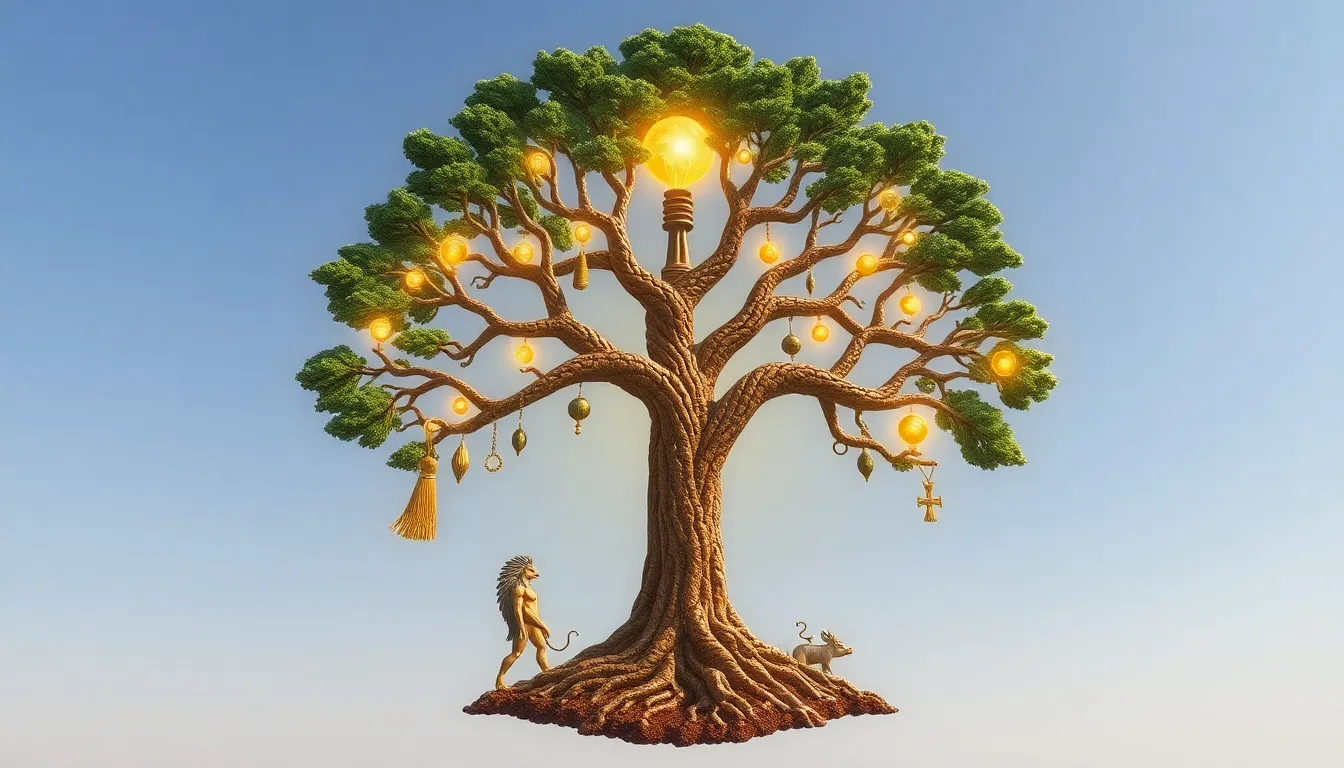The Cosmic Tree: Symbolism in Egyptian Mythology
I. Introduction
The Cosmic Tree, often referred to in various cultures as the Tree of Life, holds a significant place in Egyptian mythology, symbolizing the interconnectedness of all life and the universe. In ancient Egypt, trees were not merely seen as flora; they were vital components of the spiritual landscape, representing both the physical and metaphysical realms.
This article explores the deep symbolism of the Cosmic Tree within the context of Egyptian mythology, examining its origins, characteristics, and its profound implications for concepts such as creation, the afterlife, and the divine.
II. The Concept of the Cosmic Tree in Ancient Egypt
The Cosmic Tree has its roots in the rich tapestry of ancient Egyptian beliefs. It symbolizes life, growth, and the cyclical nature of existence.
A. Origin and historical context
Historically, the Cosmic Tree concept can be traced back to early dynastic periods, where it was often depicted in art and literature, reflecting the Egyptians’ deep reverence for nature and its mysteries.
B. Key characteristics and attributes
- Life and Fertility: The Cosmic Tree represents life and fertility, often associated with the Nile’s annual flooding which brought life to the land.
- Growth and Regeneration: It embodies the cyclical processes of growth, death, and rebirth.
- Interconnectedness: The roots, trunk, and branches symbolize the connection between the earth, the heavens, and the underworld.
C. The Cosmic Tree as a representation of life and the universe
In essence, the Cosmic Tree serves as a microcosm of the universe, illustrating the belief that all forms of life are interconnected and that the natural world is imbued with divine significance.
III. The Role of the Cosmic Tree in Creation Myths
The Cosmic Tree plays a pivotal role in several Egyptian creation myths, illustrating how life emerged from the chaos of the primordial waters.
A. Connection to the creation of the world
In many creation stories, the Cosmic Tree is depicted as the first living entity, emerging from the waters of Nun, the chaotic abyss, symbolizing the birth of order from chaos.
B. The Cosmic Tree in the story of Osiris and Isis
The tale of Osiris and Isis also incorporates the Cosmic Tree. Osiris, after being resurrected by Isis, is often associated with the growth and renewal represented by this tree, symbolizing eternal life.
C. Symbolism of growth and regeneration
The Cosmic Tree signifies not just the beginning of life but also the endless cycles of regeneration, reflecting the Egyptians’ understanding of life, death, and rebirth.
IV. The Cosmic Tree and the Afterlife
The concept of the Cosmic Tree extends into the realm of the afterlife, where it symbolizes immortality and the soul’s journey.
A. The Tree of Life and its significance in the afterlife
The Tree of Life is often depicted in tombs and funerary texts, representing the path to eternal life and the nourishment of the soul.
B. Role in rituals and funerary practices
Rituals surrounding death often included references to the Cosmic Tree, emphasizing its role in guiding the deceased to the afterlife.
C. Associated deities and their connections to the Cosmic Tree
- Osiris: The god of the afterlife, often connected to themes of resurrection.
- Isis: The goddess of magic and motherhood, representing nurturing and protection.
- Horus: The sky god, often associated with kingship and protection.
V. Symbolic Representations of the Cosmic Tree
The Cosmic Tree is richly represented in ancient Egyptian art and iconography.
A. Artistic depictions in tombs and temples
In tomb paintings and temple carvings, the Cosmic Tree is often depicted alongside deities, signifying its importance in both life and afterlife.
B. Iconography and imagery associated with the Cosmic Tree
Common symbols include:
- Branches: Representing the heavens.
- Roots: Signifying the underworld.
- Fruit: Symbolizing fertility and the sustenance of life.
C. Comparisons with other cultural interpretations of similar symbols
Similar concepts of the Cosmic Tree can be found in other cultures, such as the Norse Yggdrasil or the Hindu Ashvattha tree, illustrating a universal archetype in mythology.
VI. The Cosmic Tree and Egyptian Deities
Several deities in Egyptian mythology are intimately connected with the Cosmic Tree, reinforcing its significance.
A. Key deities associated with the Cosmic Tree, such as Nut and Geb
- Nut: The sky goddess, often depicted arching over the tree.
- Geb: The earth god, representing the grounding aspect of the tree.
B. The interplay between nature and divinity
The relationship between these deities and the Cosmic Tree exemplifies the Egyptians’ understanding of nature as a manifestation of divine will.
C. Myths involving deities and the Cosmic Tree
Numerous myths detail interactions between these deities and the Cosmic Tree, weaving narratives that celebrate the harmony between the natural and divine realms.
VII. The Legacy of the Cosmic Tree in Modern Interpretations
The Cosmic Tree’s symbolism continues to resonate in contemporary culture.
A. Influence on contemporary spirituality and symbolism
Modern spiritual practices often draw upon the symbolism of the Cosmic Tree, representing growth, connection, and the cycle of life.
B. The Cosmic Tree in modern literature and art
Literary works and artworks today frequently reference the Cosmic Tree, reflecting its enduring significance.
C. Comparative analysis with other mythological trees across cultures
By comparing the Cosmic Tree with similar symbols in other traditions, we can gain deeper insights into the universal themes of life and interconnectedness.
VIII. Conclusion
The Cosmic Tree stands as a powerful symbol in Egyptian mythology, representing the profound interconnections between life, death, and rebirth. Its rich symbolism spans creation myths, the afterlife, and the divine, highlighting the Egyptians’ deep reverence for nature and its cycles.
As we reflect on the legacy of the Cosmic Tree, we recognize its enduring relevance in modern contexts, emphasizing the timeless nature of its message about the interconnectedness of all life. The Cosmic Tree remains a potent symbol of the cycle of existence, reminding us of the beauty and complexity of the universe we inhabit.




